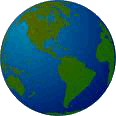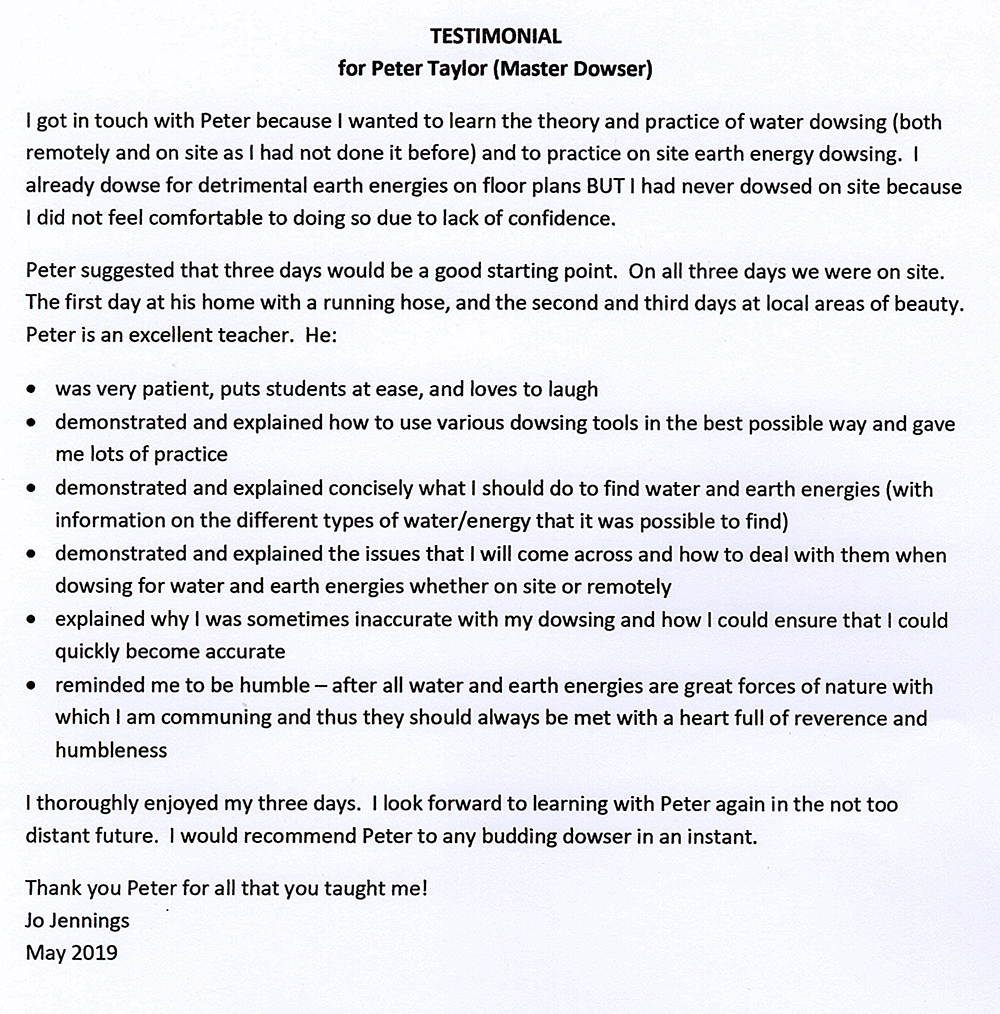 |

dowsing water, noble minerals,
oil/gas fields, geopathic stress using advanced map dowsing
|
|
|
Teaching
Testimonials & Blog

August 2016 – Teaching –
email from Student
Hi Peter -
thankyou so much for a brilliant day! I loved it.
As I said I have felt frustrated for
so long.
I am saving up for another day which
I am hoping will be in the Autumn.
I would love
to come to your monthly meetings so yes please do put me on
your list.
I can only come in October and
possibly December, dependent on some work that is being
arranged.
Hopefully I will make more in 2017.
As I said I
am really keen to come and help with boreholes. It feels that
it is real and I would learn a huge amount from it.
I am so happy
to have found such a brilliant teacher - I am so excited.
I hope you
have a great summer
warm wishes
Dowsing
Posted on August 9,
2016 by Lisa
“The
use of pendulum or rods to find water or minerals”
“the use of apparently paranormal powers to make discoveries”
Hamish
Miller, The Definitive Wee Book on Dowsing.
A few days
ago some friends and I set out into nearby Wales to meet a man
called Peter Taylor to spend a day being introduced to the
ancient art of dowsing for water. Peter has been a
professional dowser for some decades, working to locate water,
oil and gas and even gold here in the UK and around the world
as well as working with earth energies and tackling problems of
geopathic stress. He is a respected and award-winning member
of the British Society of Dowsers and advises their local group
in North Wales.
Beginning indoors at the Rhydymwyn
Valley visitor centre, Peter took us through the basics of
using various dowsing tools, pendulums; copper and other metal
L-shaped rods and y-shaped “sticks” made, not out of the
traditional hazel, but what looked like pieces of plastic
curtain track. There was also a w-shaped apparatus which was
very sensitive and I’m not sure any of us quite got the hang of
it. The important lesson here was to try different tools to
see which worked best for the individual. I had previously
only used a pendulum and was happy that the L shaped rods of
various sizes seemed natural and easy to use. Whichever tool
you use the idea is the same – the tool is held gently at rest
but in a way so that it is able to move. You then form a
question in your mind or hold the idea of what you wish to
physically locate and the tool moves to give a yes/no answer to
the question or when the correct physical location is reached.
Firstly we were shown how to use the tools to test whether
we were “positive” enough to be able to dowse – and to assess
just how high our positivity was. Everyone uses their own
metaphors or constructs and I liken this positivity to being in
the right frame of mind to receive whatever information it is
one tunes into when dowsing. I was originally introduced to
dowsing as part of my first reiki course when it was explained
as a way of finding out what you know when you don’t know you
know it. In other words, our minds and connections to our
bodies are so complex that there is information hidden away
that we can’t always directly access and need to use a tool to
help us divine it. So dowsing can be viewed as a reasonably
explicable method of allowing our subconscious to express
information through body micro movements that are converted by
the tool used into large enough movements to be sensed by the
conscious mind. In other words, we already know or perceive
the answer to our question but the dowsing tool enables us to
make it explicit.
Peter then talked us through some of
the basics of the incredibly complex issues around finding
information about underground water. It’s certainly not just a
question of “here be water” – which is what I had thought
having only really met water divining before in Arthur
Ransome’s classic novel “Pigeon Post” where the children want
to camp up high on the fell but the springs have dried up in
the drought. They try dowsing with hazel rods and one of the
group manages to find a spot which, when dug out, forms a
beautiful natural well perfect for their needs. Modern water
dowsing needs to determine the quality of the water, where and
at what rate it’s flowing, how far down it is, what’s between
the water and the surface and more besides. If a dowser is not
accurate enough, a lot of expensive drilling can be wasted to
no effect. Peter says that if you can learn to dowse for
water, you can dowse for anything, and I can see that it’s a
rigorous discipline.
Slightly fazed by all the
technicalities we headed outside to try some practical
dowsing. The Rhydymwyn Valley Works Site is now a nature
reserve but was used during the war to produce mustard gas
shells and also hosted the initial phases of the atom bomb
research before it was moved to the US. Buildings that now
house colonies of bats are being reclaimed by plants and other
wildlife while the spooky network of underground tunnels are
sealed off and can only be glimpsed from outside. It’s a
fascinating place well worth a visit but we were there to see
if we could dowse for the underground water courses. Running
through it is the river Alyn, a tributary of the Dee, which is
a river of many guises as the mining works around Loggerheads
and beyond create many caves and sinkholes where its waters
become lost underground. At Rhydymwyn it mostly flows through
a culvert sometimes open and sometimes covered.
Peter
encouraging one of our group dowsing with L-rods and water
samples. So, how did we do? Did we find water? Yes, we did.
Hamish Miller says that anyone can dowse, Peter thinks about 9
out of 10 can. Out of the five of us, all ended up getting
reactions to at least some of the underground water flows
although some managed it quicker than others. Peter
demonstrated this by taking us to sites where he knew the
underground water profile and leaving us to individually try
and locate the flows, “reaction” lines either side of the
flows, directions, depths and rates of flow. We each used our
tool of choice and marked out our findings with a set of
coloured flags and all achieved at least some accurate
pinpointing of location – although working out what it was we
had located was more problematic. It was easy to confuse water
flow with edge of culvert or reaction line. It was relatively
easy to divine direction of flow and some of us got at least
some accurate readings of flow volume. After we’d had an
initial go divining the Alyn underground Peter took us to look
at the river where it was visible and then back to the
underground site. Remarkably I found it much easier to get
accurate information having seen the river in the flesh, so to
speak. Apparently the more you know about the subject you’re
trying to dowse for, the more easily you can do it and the more
accurate your responses.
After a break for lunch we
moved to Loggerheads to follow the Alyn as it flowed in the
valley and then disappeared completely, leaving the stream bed
dry, into sinkholes and old mine works. Along the edge of the
dry river bed there are therefore several places where there
are considerable underground flows and, because the cavities
are largely man-made, the flow of the water isn’t always
predictable from the surface. The volumes of flow were much
larger than we’d encountered on the Rhydymwyn site and Peter
thought it would be a good learning experience to see how this
affected the performance of the rods. To be honest, I think we
did less well here than we had in the morning. There was water
all around in some places and perhaps this made the dowsing
more difficult for us rank amateurs. We were also becoming
tired and, increasingly, it was difficult to stay “positive” or
in the correct frame of mind. It was good fun though, and we
provided interest for the other walkers!
So what did we
learn from the day? I took away several very useful things for
my own practice of dowsing. Firstly, knowledge of your subject
is important. I personally believe that I am dowsing when I do
reflexology in that the energetic representation of the body’s
parts and organs on the feet are sensed as reflexes in various
ways – in this case my tools are my fingers and my mind.
Knowing more about reflexology and being a more experienced
reflexologist therefore helps me to “dowse” the reflexes to
assess what might need to be done in the treatment session.
Secondly, the importance of being “positive”, or in the right
frame of mind was reinforced. I think there are different ways
of doing reflexology but the way I work is definitely enhanced
by the ability to tap in to the information in my clients’
reflexes and this requires quiet, stillness and the right frame
of mind to form the connection. And lastly Peter confirms what
I have learned elsewhere – the importance of ethical practice.
The BSD code of ethics is a very good example.
My
friends too came away with a very positive attitude to their
first ever taste of dowsing. They all agreed there was
definitely “something to it” and felt that their experiences of
feeling the dowsing tools move to relay information were real
and in many cases accurate. Accuracy can only be improved by
practice and Peter advises at least 3 days to have a good stab
at learning water dowsing. They continue to mull over the
experience and agree it was a thoroughly interesting way to
spend a day.
And lastly – so how does dowsing work? The
importance of being “positive”, or being in the right state of
mind, is paramount. In this way we can tap into our
subconscious and information that may have previously been
hidden. This might be construed as being an ancient sense that
Man used in his early days to connect with the landscape and
find water – or anything else he needed to find. But what if
the information cannot possibly have been there in any
explicable way beforehand? What if someone could use dowsing
to, for example, predict the lottery results or stock market
movements? Would that be a tapping in to knowledge that is
somehow already there? Many believe that there is an extra
dimension to dowsing and similar work, call it what you will –
energy, spirit, collective unconscious. By stilling our
chattering everyday mind, becoming open and paying real
attention to what is in, around and about us in the universe
there is an infinite source of information that can be
accessed. I experience and am grateful for it in my therapy
work and it is there for everyone else. Just remember to be
ethical in your approach, as in all of life.
Further
reading:
The Definitive Wee Book on Dowsing, a journey
beyond our five senses – Hamish Miller. One of the covetable
and tactile Wooden Books series, watch out, they’re addictive
(but fortunately not expensive).
Spiritual Dowsing – Sig
Lonegren. Some good stuff in here too.
The Sun and the
Serpent – Paul Broadhurst and Hamish Miller. The story of
tracing the Michael and Mary earth energy lines across the UK.
|
|
|
|
|
|
|